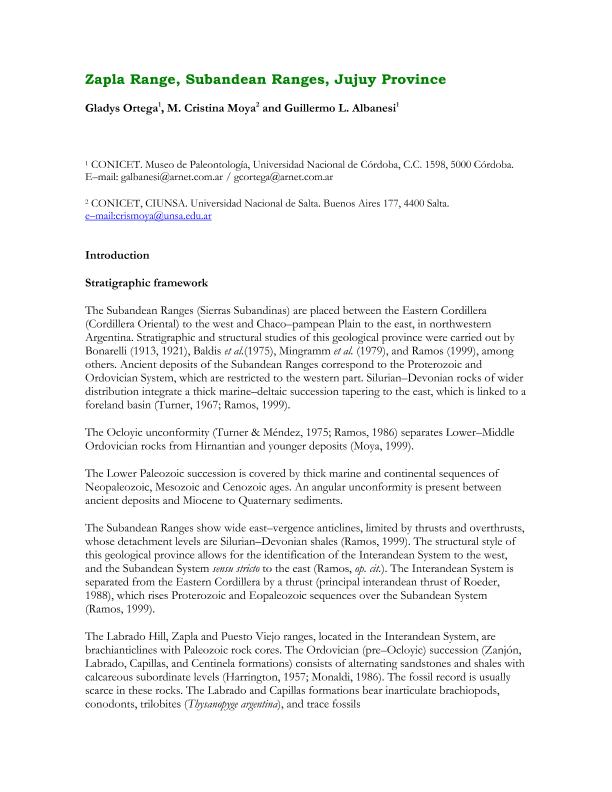Artículo
Zapla range, subandean ranges, Jujuy province
Fecha de publicación:
2003
Editorial:
Universidad Nacional de Tucumán. Facultad de Ciencias Naturales e Instituto Miguel Lillo. Instituto Superior de Correlación Geológica
Revista:
Serie Correlación Geológica
ISSN:
1668-3242
Idioma:
Inglés
Tipo de recurso:
Artículo publicado
Clasificación temática:
Resumen
The Subandean Ranges (Sierras Subandinas) are placed between the Eastern Cordillera (Cordillera Oriental) to the west and Chaco–pampean Plain to the east, in northwestern Argentina. Stratigraphic and structural studies of this geological province were carried out by Bonarelli (1913, 1921), Baldis et al.(1975), Mingramm et al. (1979), and Ramos (1999), among others. Ancient deposits of the Subandean Ranges correspond to the Proterozoic and Ordovician System, which are restricted to the western part. Silurian–Devonian rocks of wider distribution integrate a thick marine–deltaic succession tapering to the east, which is linked to a foreland basin (Turner, 1967; Ramos, 1999). The Ocloyic unconformity (Turner & Méndez, 1975; Ramos, 1986) separates Lower–Middle Ordovician rocks from Hirnantian and younger deposits (Moya, 1999). The Lower Paleozoic succession is covered by thick marine and continental sequences of Neopaleozoic, Mesozoic and Cenozoic ages. An angular unconformity is present between ancient deposits and Miocene to Quaternary sediments. The Subandean Ranges show wide east–vergence anticlines, limited by thrusts and overthrusts, whose detachment levels are Silurian–Devonian shales (Ramos, 1999). The structural style of this geological province allows for the identification of the Interandean System to the west, and the Subandean System sensu stricto to the east (Ramos, op. cit.). The Interandean System is separated from the Eastern Cordillera by a thrust (principal interandean thrust of Roeder, 1988), which rises Proterozoic and Eopaleozoic sequences over the Subandean System (Ramos, 1999). The Labrado Hill, Zapla and Puesto Viejo ranges, located in the Interandean System, are brachianticlines with Paleozoic rock cores. The Ordovician (pre–Ocloyic) succession (Zanjón, Labrado, Capillas, and Centinela formations) consists of alternating sandstones and shales with calcareous subordinate levels (Harrington, 1957; Monaldi, 1986). The fossil record is usually scarce in these rocks. The Labrado and Capillas formations bear inarticulate brachiopods, conodonts, trilobites (Thysanopyge argentina), and trace fossils (Cruziana and Skolithos ichnofacies), which indicate an Arenig age. The Capillas Formation includes a more diverse fauna ("Brongniartella zaplensis", "Hoekaspis schlagintweiti", Ctenodonta sp., Lingula sp., nautiloids, and ichnites) that is referred to the Llanvirn. The Centinela Formation yields inarticulate brachiopods, trilobites ("Brongniartella zaplensis"), and skolithos (Monaldi et al., 1986). Post–Ocloyica deposits commence in the upper Ashgill (Hirnantian) and evolve during the Silurian and Devonian. They are bounded by the Chánica unconformity (Late Devonian – Early Carboniferous). The Hirnantian Zapla Formation (Schlagintweit, 1943) is made of clastic heterogeneous deposits with subordinate sandstones and shales, and scarce fossils. The record of Dalmanitina subandina allowed to referring this unit to the Hirnantian (Monaldi & Boso, 1987). The glacial or glaci–marine origin attributed to this formation is linked to the presence of striate and facet clasts (cf., Turner, 1964; Boso, 1999). Silurian deposits of the Lipeón Formation overlie Hirnantian or younger units.
Palabras clave:
ZAPLA
,
TILCARA
,
CORDILLERA ORIENTAL
Archivos asociados
Licencia
Identificadores
Colecciones
Articulos(CCT - SALTA-JUJUY)
Articulos de CTRO.CIENTIFICO TECNOL.CONICET - SALTA-JUJUY
Articulos de CTRO.CIENTIFICO TECNOL.CONICET - SALTA-JUJUY
Citación
Ortega, Gladys del Carmen; Moya, Maria Cristina; Albanesi, Guillermo Luis; Zapla range, subandean ranges, Jujuy province; Universidad Nacional de Tucumán. Facultad de Ciencias Naturales e Instituto Miguel Lillo. Instituto Superior de Correlación Geológica; Serie Correlación Geológica; 11; 2003; 1-6
Compartir




